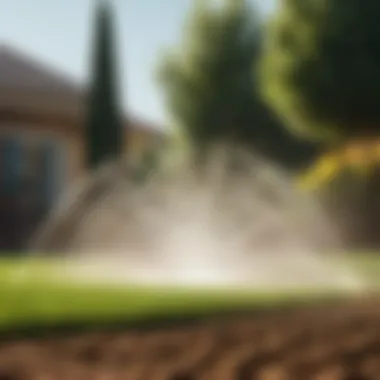Materials:
- PVC pipes (quantity: 100ft)
- Sprinkler heads (quantity: 10)
- Control valves (quantity: 1)
- Pipe fittings (quantity: as per requirement)
DIY Steps:
- Start by planning the layout of your lawn irrigation system. Consider the size of your lawn, water pressure, and landscaping features.
- Dig trenches according to the planned layout to accommodate PVC pipes and sprinkler heads.
- Assemble the PVC pipes, ensuring they are cut to the appropriate lengths for the layout.
- Install sprinkler heads at designated spots in the trenches, connecting them to the PVC pipes.
Technical Aspects:
- Tools required: Shovel, hacksaw, PVC pipe cutter, Teflon tape.
- Timing specifics: Plan for at least a weekend to complete the installation, depending on the lawn size.
- Critical techniques: Ensure proper leveling of the pipes to avoid water wastage and inefficiency.
DIY Project Process:


- Start by laying out the PVC pipes in the trenches, connecting them with pipe fittings as needed.
- Attach control valves at key points to regulate water flow to different zones of the lawn.
- Test the system for leaks and proper functioning before burying the pipes.
Troubleshooting Tips:


- If experiencing leaks, check connections for proper sealing with Teflon tape.
- Adjust sprinkler heads' direction and range for optimal coverage of the lawn.
Factors Influencing Pricing


In the realm of lawn irrigation systems, understanding the factors influencing pricing plays a pivotal role in the decision-making process. Various elements come into play when determining the cost of installation, ranging from the choice of irrigation system to the size and complexity of the lawn, and even the type of soil and topography present. By comprehensively examining these aspects, individuals can gain a clearer picture of the financial considerations involved in acquiring a top-notch irrigation setup.
Choice of Irrigation System
When delving into the world of irrigation systems, the choice made between different options such as drip irrigation, spray irrigation, and rotor systems significantly impacts the overall price. Drip irrigation, known for its targeted and efficient water delivery directly to the roots of plants, stands out as a popular choice due to its water conservation benefits. In contrast, spray irrigation covers larger areas with overhead water distribution, suitable for a diverse range of lawn sizes and shapes. Rotor systems, characterized by their rotating water stream, offer flexibility in coverage but may require more maintenance.
Lawn Size and Complexity
The size and complexity of a lawn dictate the amount of irrigation needed for optimal plant growth. Small lawns require simpler and less elaborate irrigation systems, fitting for compact spaces with lower water requirements. Medium-sized lawns strike a balance between coverage and efficiency, catering to average-sized residential areas. On the other end, large and elaborate lawns demand advanced irrigation solutions to ensure comprehensive water distribution across vast landscapes, enhancing overall greenery aesthetically and functionally.
Soil Type and Topography
The soil type and topography of a lawn influence the choice of irrigation system and ultimately impact the pricing. Sandy soil, characterized by its quick-draining properties, necessitates irrigation systems that can deliver water effectively without runoff. Clay soil, known for its water retention capabilities, requires careful consideration to prevent overwatering. Hilly terrains pose a challenge due to varying elevation levels, demanding customized irrigation solutions that can adapt to the landscape's contours and deliver water efficiently.
Equipment Costs
Main Control Unit
Smart Controllers
Smart controllers stand out as a technologically advanced component within the realm of main control units for irrigation systems. Their key characteristic lies in the ability to regulate watering schedules based on real-time data, such as weather conditions and soil moisture levels. This intelligent functionality not only optimizes water usage but also promotes healthier lawn growth by delivering water precisely when and where it is needed. Smart controllers are a popular choice for those seeking convenience and environmental sustainability, as they offer the advantage of automated control without the need for manual adjustments.
Basic Timers
In contrast to smart controllers, basic timers provide a more straightforward approach to scheduling irrigation cycles. They offer a reliable and cost-effective solution for homeowners looking to set fixed watering times without the complexity of dynamic adjustments. The key characteristic of basic timers is their user-friendly interface and ease of programming, making them a popular choice for those who prefer a simpler irrigation system setup. While basic timers may lack the advanced features of smart controllers, they remain a practical option for individuals seeking a hassle-free irrigation scheduling solution.
Sprinkler Heads
Rotary Heads
Rotary heads are a versatile option for delivering water in a rotating pattern, covering a substantial area with uniform distribution. The key characteristic of rotary heads is their ability to provide efficient coverage for larger lawn spaces, making them an optimal choice for expansive landscapes. Their unique feature lies in the adjustable spray patterns, allowing users to customize the watering range based on specific lawn dimensions. While rotary heads excel in widespread water distribution, one potential disadvantage is the higher initial cost compared to other sprinkler head types.
Fixed Spray Heads
Fixed spray heads are designed to emit water in a fixed pattern, making them ideal for targeted watering of specific areas within a lawn. The key characteristic of fixed spray heads is their precision in delivering water with minimal overspray, ensuring efficient moisture distribution to designated zones. Their unique feature lies in the ability to adjust spray distances and angles, catering to diverse lawn layouts with varying watering needs. While fixed spray heads offer precise water control, one disadvantage is the potential for water wastage if not properly adjusted for individual lawn requirements.
Piping and Valves
PVC Pipes
PVC pipes serve as a durable and reliable choice for transporting water throughout an irrigation system. The key characteristic of PVC pipes is their resistance to corrosion and environmental degradation, ensuring long-term performance and water flow stability. Their unique feature lies in the ease of installation and flexibility to accommodate varying soil conditions and terrain types. While PVC pipes offer excellent longevity and cost-effectiveness, one potential disadvantage is the rigidity of installation pathways, which may pose challenges in situations requiring intricate pipe layouts.
Drip Tubing
Drip tubing offers a targeted and efficient method for delivering water directly to plant roots, minimizing water runoff and evaporation. The key characteristic of drip tubing is its ability to promote water conservation by reducing wastage through precise irrigation. Their unique feature lies in the customizable drip emitters, allowing users to adapt water flow rates based on plant types and soil moisture requirements. While drip tubing excels in water efficiency, one consideration is the regular maintenance needed to prevent clogging and ensure consistent water delivery.
Zone Valves
Zone valves function as the control mechanisms for regulating water flow to different irrigation zones within a system. The key characteristic of zone valves is their ability to segment a lawn into distinct areas for customized watering schedules. Their unique feature lies in the automated control of water distribution, facilitating efficient irrigation without manual intervention. While zone valves offer convenience and flexibility in managing irrigation zones, one potential disadvantage is the complexity of installation and maintenance, which may require professional assistance to ensure proper functioning and synchronization.
Labor Costs
In the realm of installing a lawn irrigation system, labor costs play a pivotal role in the overall expenditure. Delving into the intricacies of labor costs is crucial for grasping the comprehensive understanding of the financial investment that goes into such a project. Labor costs encompass a variety of elements, including installation and maintenance, directly impacting the final budget homeowners need to allocate for their irrigation system. It is essential to comprehend the breakdown of labor costs to make informed decisions and plan efficiently.
Installation
Excavation
Excavation stands as a foundational element within the installation process of a lawn irrigation system. It involves the digging of trenches to lay down pipes and other essential components necessary for the system to function optimally. The key characteristic of excavation lies in its ability to create a network of channels that facilitate the flow of water to designated areas of the lawn. This method proves to be a popular choice due to its efficiency in ensuring proper water distribution across the landscape. Despite being labor-intensive, excavation offers the advantage of precision and customization, allowing tailored placement of irrigation elements to suit specific lawn layouts.
Pipe Installation
The process of pipe installation is a vital stage in setting up a functional lawn irrigation system. It involves laying down pipes that connect to the main water source and distribute water throughout the designated zones of the lawn. The key characteristic of pipe installation lies in its role as the circulatory system of the irrigation setup, ensuring seamless water delivery to the designated areas. This method is popular for its reliability and durability, providing a long-term solution for proper lawn hydration. Pipe installation's unique feature lies in its adaptability to different lawn sizes and layouts, offering versatility in catering to various lawn irrigation needs.
Testing
Testing serves as a critical aspect of the installation phase of a lawn irrigation system. It involves thorough checks and assessments to ensure that all components, including pipes, valves, and controllers, function correctly and efficiently. The key characteristic of testing is its role in identifying and addressing any potential issues or malfunctions before the system goes fully operational. This step is beneficial as it aids in preventing future breakdowns and ensures the system's overall effectiveness. Testing's unique feature lies in its contribution to the system's longevity and performance, providing homeowners with peace of mind regarding their investment.
Maintenance
Seasonal Checkups
Seasonal checkups are a fundamental part of maintaining a lawn irrigation system's optimal performance throughout the year. These routine inspections involve assessing the system's functionality, adjusting settings as needed, and identifying any potential damages or inefficiencies. The key characteristic of seasonal checkups is their proactive approach to system maintenance, allowing for early detection of issues and prompt resolution. This practice proves beneficial in ensuring consistent water distribution and preventing costly repairs in the future. Seasonal checkups' unique feature lies in their capability to enhance the system's efficiency and longevity, maximizing its effectiveness in keeping the lawn green and healthy.
Repairs
Repairs constitute a vital element of maintaining a lawn irrigation system's functionality over time. When components of the system break down or malfunction, repairs become necessary to restore proper operation. The key characteristic of repairs is their ability to address specific issues promptly, preventing further damage to the system. This practice proves beneficial in extending the system's lifespan and preventing potential wastage of water or inefficient irrigation. Repairs' unique feature lies in their cost-effectiveness and ability to prolong the overall functionality of the lawn irrigation system.
Permit and Inspection Fees
In the realm of installing a lawn irrigation system, obtaining permits and undergoing inspections play a pivotal role in ensuring the legitimacy and functionality of the system. Permit and inspection fees are not merely bureaucratic hurdles but essential components for a seamless and compliant irrigation setup. These fees contribute to the overall cost of the project while guaranteeing that the system meets regulatory standards and guidelines.
Local Regulations
Permit Requirements
Within the landscape of lawn irrigation projects, Permit Requirements serve as the cornerstone for adherence to local building codes and regulations. These requirements outline the necessary steps and specifications that must be met before commencing the installation process. By delving into Permit Requirements, individuals gain insight into the specific criteria set by local authorities, ensuring that the irrigation system is in harmony with established guidelines.
These requirements are a vital aspect of the installation process, emphasizing safety, efficiency, and environmental considerations. Compliance with Permit Requirements not only safeguards the investment in the irrigation system but also fosters a sustainable and responsible approach to water usage in residential settings. Engaging with Permit Requirements enables homeowners to navigate the regulatory landscape with precision and certainty, paving the way for a successful and legally compliant installation.
Inspection Processes
On the heels of installation, Inspection Processes emerge as a crucial phase in validating the functionality and efficacy of the lawn irrigation system. Conducted by authorized inspectors, these processes involve a meticulous evaluation of the system to confirm that it operates optimally and aligns with predefined standards. The Inspection Processes serve as a quality assurance measure, certifying that the irrigation system meets performance benchmarks and fulfills regulatory requirements.
Throughout the inspection journey, homeowners benefit from a thorough assessment that highlights any potential issues or areas for improvement. By scrutinizing the system post-installation, Inspection Processes assure homeowners of a reliable and efficient irrigation setup for their lawn. Beyond mere compliance, these processes exemplify a commitment to excellence and diligence, providing homeowners with the peace of mind that their investment in a lawn irrigation system is both sound and sustainable.
Additional Considerations
When investing in a lawn irrigation system, certain additional considerations play a crucial role in ensuring the efficiency and effectiveness of the system. These aspects go beyond the basic components of the system and can significantly influence the overall cost and performance. Two key additional considerations that merit careful attention are the water source and the integration of automation and smart features.
Water Source
The water source represents a fundamental element that directly impacts the sustainability and functionality of a lawn irrigation system. In the context of this article, we explore two primary water source options: city water connection and well water usage.
City Water Connection
City water connection involves tapping into the municipal water supply to irrigate your lawn. This option is favored for its reliability and consistent water pressure, ensuring adequate coverage for all areas of your landscape. The key characteristic of city water connection lies in its convenience and accessibility, making it a popular choice among homeowners looking for a hassle-free irrigation solution.
One notable advantage of city water connection is the quality of water provided, which is typically treated and safe for use in irrigation, promoting healthy growth in your lawn. However, a potential drawback is the cost associated with water usage, as municipal water rates can vary depending on location.
Well Water Usage
Conversely, well water usage involves drawing water from a private well on your property to fulfill irrigation needs. This option offers independence from municipal water supplies, which can be beneficial in areas where access to city water is limited or expensive. The main characteristic of well water usage is the control it provides over water sourcing, allowing homeowners to manage their water supply effectively.
A key advantage of well water is its potential cost savings in the long run, as you are not dependent on monthly water bills. However, the quality of well water may vary depending on local conditions, requiring periodic testing and potential filtration systems to ensure purity for irrigation purposes.
Automation and Smart Features
In the modern landscape of lawn care, automation and smart features have revolutionized the way irrigation systems function. By incorporating advanced technologies into your system, you can optimize water usage, improve efficiency, and enhance the overall performance of your irrigation setup.
Weather Sensors
Weather sensors are a valuable addition to any irrigation system, providing real-time data on environmental conditions to adjust watering schedules accordingly. The primary characteristic of weather sensors is their ability to detect changes in precipitation, humidity, and temperature, enabling smart controllers to deliver precise amounts of water based on actual weather patterns.
The key benefit of weather sensors lies in their ability to prevent overwatering or underwatering, saving water and promoting healthier plant growth. However, one possible disadvantage is the initial investment required for weather sensor installation, which may deter some homeowners from adopting this technology.
Remote Access
Remote access capability allows homeowners to control and monitor their irrigation system from anywhere using a smartphone or computer. This feature offers convenience and flexibility by enabling adjustments to watering schedules, settings, and water flow rates remotely.
The main characteristic of remote access is its user-friendly interface and the convenience it provides for busy homeowners who want to manage their irrigation system efficiently. Its primary advantage lies in the ability to monitor system performance in real time and make immediate changes as needed. However, reliability on internet connectivity may pose a limitation for remote access in areas with unstable networks.





